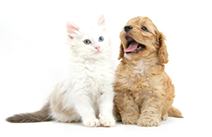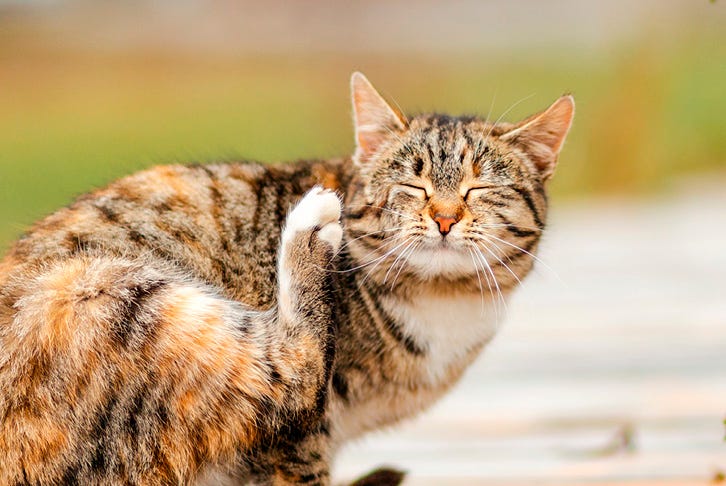Fleas
Fleas are a common problem, even for the most pampered animal, causing skin irritation and discomfort. While the irritation of fleas is usually more noticeable in spring and summer, fleas can stay active all year round, even in winter if you have a warm, dry house for them to thrive in.
How to tell if your pet has fleas
Your pet may be scratching or grooming a lot more than normal and you may see the fleas or flea dirt in their coat. You may have also experienced flea bites yourself.
Steps to treat and infestation:
- RAPID KILL - with a treatment to kill all live fleas quickly
- TREATMENT - with a topical or oral treatment
- CLEAN - wash your pet's bedding in hot water and detergent
- ENVIRONMENT - Flea bomb your house and car, treat all pets in the household at the same time
- PREVENTION - ongoing regular treatment with a topical / collar / oral application
How does your pet get fleas?
Adult fleas lay eggs on the animal’s coat. A single female flea can lay up to 50 eggs a day. These eggs then fall from the pets coat and into the environment such as the garden or carpet, this is why treating not only your pet but their surrounds too is the only way to ensure you have broken the cycle.

The flea life cycle
The infestation can start long before you see them jumping and biting. A single female can lay up to 2,000 eggs in her lifetime. Flea bites can cause your pet’s skin to be irritated, just one flea can bite your pet 400 times a day. Heavy flea infestations can also cause serious problems, including anaemia in young or sick animals, or severe allergies to flea bites (called Flea Allergy Dermatitis).
Flea protection
The best solution for avoiding fleas is all year round protection. This will ensure you and your home will remain flea free every day of the year. It's essential that you choose a flea protection program that is effective and safe for your pet and environment that will ensure every life cycle of the flea is treated, from eggs to larvae to pupae and to adult fleas. There are a wide range of flea treatments available from spot ons, to flea collars, to flea shampoos and powders, flea combs and sprays; we can help you find the best product for your needs to beat the cycle.
Flea eradication
Only 5% of fleas are on your pet at any one time; 95% are in different lifestyle stages in your house. Therefore it is important to not only treat your pet, but also their environment. Ensure you clean animal bedding and the surrounding area thoroughly and vacuum all floors and furniture. If fleas persist there are a variety of sprays available to help rid your home of fleas. You can also use pest eradication experts for more serious cases. Please contact us for further advice on parasite control.
How to tell if your pet has fleas
Your pet may be scratching or grooming a lot more than normal and you may see the fleas or flea dirt in their coat. You may have also experienced flea bites yourself.
Steps to treat and infestation:
- RAPID KILL – with a treatment to kill all live fleas quickly
- TREATMENT – with a topical or oral treatment
- CLEAN – wash your pet's bedding in hot water and detergent
- ENVIRONMENT – Flea bomb your house and car, treat all pets in the household at the same time
- PREVENTION – ongoing regular treatment with a topical / collar / oral application
How does your pet get fleas?
Adult fleas lay eggs on the animal’s coat. A single female flea can lay up to 50 eggs a day. These eggs then fall from the pets coat and into the environment such as the garden or carpet, this is why treating not only your pet but their surrounds too is the only way to ensure you have broken the cycle.
 The flea life cycle
The flea life cycle
The infestation can start long before you see them jumping and biting. A single female can lay up to 2,000 eggs in her lifetime. Flea bites can cause your pet’s skin to be irritated, just one flea can bite your pet 400 times a day. Heavy flea infestations can also cause serious problems, including anaemia in young or sick animals, or severe allergies to flea bites (called Flea Allergy Dermatitis).
Flea protection
The best solution for avoiding fleas is all year round protection. This will ensure you and your home will remain flea free every day of the year. It's essential that you choose a flea protection program that is effective and safe for your pet and environment that will ensure every life cycle of the flea is treated, from eggs to larvae to pupae and to adult fleas. There are a wide range of flea treatments available from spot ons, to flea collars, to flea shampoos and powders, flea combs and sprays; we can help you find the best product for your needs to beat the cycle.
Flea eradication
Only 5% of fleas are on your pet at any one time; 95% are in different lifestyle stages in your house. Therefore it is important to not only treat your pet, but also their environment. Ensure you clean animal bedding and the surrounding area thoroughly and vacuum all floors and furniture. If fleas persist there are a variety of sprays available to help rid your home of fleas. You can also use pest eradication experts for more serious cases.








